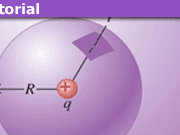Why Don’t Electrons Crash into the Nucleus in Atoms?
Table of Contents
Atoms and Coulomb Forces
If one describes atoms using only the Coulomb forces, the electron and the nucleus will attract each other and no stable atoms could exist. This is not the case. Niels Bohr was the first (1913) to propose a better model, which consisted of electrons moving around the nucleus in circular orbits. Each orbit corresponds to a certain discrete energy level. This model is based on the quantization of the angular momentum.
Electron Acceleration
Unfortunately, electrons moving in a circular orbit have an acceleration due to the centripetal force. In classical electromagnetic theory, an accelerated charged particle must emit EM-radiation due to energy conservation. Hence, the electron would lose energy and spiral down towards the nucleus. Again stable atoms could not exist. What is wrong now?
Classic Electron Atom Model
It turns out that the picture of electrons moving in circular orbits around the nucleus isn’t correct either(*). The solution here is the implementation of Quantum Mechanics via the Schrödinger Equation and the concept of the wavefunction. By applying such formalism, the “electron” occupies a volume of space simultaneously, so that it is “smeared” in a particular geometry around the nucleus. While there are no more “orbits”, we do use the term “orbitals” to indicate the shape of such geometry. However, this term should not be confused to mean an orbiting electron similar to our planets in the solar system. Describing the system in terms of the QM wavefunction, it creates stable states for the nucleus+electrons system that match very well with the experimental observation of standard atomic spectra.
How Electron Orbits Work
Since there are no more “orbits” in the conventional sense, the problem of electrons radiating due to an accelerated motion is no longer meaningful. It explains why we have stable atoms.
To read more in detail: http://scienceworld.wolfram.com/physics/HydrogenAtom.html
(*) By saying that “an electron orbits the nucleus”, one is already implicitly assuming that one can track the position and momentum of that electron in an atom over some time. We have no such ability, and for those who know a bit about the Heisenberg Uncertainty Principle (HUP), one can already tell that such a statement violates this principle.
Contributed by Marlon and edited by ZapperZ
This article was authored by several Physics Forums members with PhDs in physics or mathematics.





[QUOTE="Jim Hasty, post: 5308064, member: 532882"]I have read somewhere that the electrons inhabit orbital shells around the nucleus; each shell a different radius.”This sounds like an old-fashioned description. We still use the terminology of shells, but shells do not have a radius. The higher energy shells do have a higher average (expected value) radius, but the electrons have some probability of being at any radius.
[QUOTE="Bernhard Kup, post: 5586054, member: 558413"]By the way: The old Bohr model of orbits is getting correct again forso-called Rydberg atoms of hight quantum numbers n = 40 to 100.So never think that only one model can explain everything!”But that is "correct" in the sense that at a large enough distance, a cow looks like a sphere.Zz.
“Multiple_Authors submitted a new PF Insights post
[URL=’https://www.physicsforums.com/insights/dont-electrons-crash-nucleus-atoms/’]Why Don’t Electrons Crash into the Nucleus in Atoms?[/URL]
[IMG]https://www.physicsforums.com/insights/wp-content/uploads/2015/12/electronatom-80×80.png[/IMG]
[URL=’https://www.physicsforums.com/insights/dont-electrons-crash-nucleus-atoms/’]Continue reading the Original PF Insights Post.[/URL]”
I assume the issue is that since accelerated charges classically emit radiation and aside from some other rather rare events etc. must therefore continuously loose kinetic energy then they will eventually run into the nucleus at least classically. The answer is that in fact physics is not correctly described by classical physics but only by quantum physics which ideally under the approximation of being a closed system will take on only certain eigenfunctions with certain eigen energies or a superposition of such states. But there is a definite minimum energy state often called the ground state of which it can be in no lower state. There is a very straightforward explanation of this and is in most all elementary quantum texts such as in authors Rojansky, Schiff etc. on the treatment of the hydrogen atom. NOw when one considers relativistic effects and field interaction and 2nd quantization it does become more complicated – perhaps requires quantum field theory when one considers interaction with E&M field in its quantum description – for example the Lamb shift. Anyway in this case when one actually calculates up to infinite frequencies infinities arise and the theory in some sense breaks down. It typically requires ‘ renormalization ‘ to actually make sense(or nonsense) of the situation. This was and in some others opinion still is a breakdown and major problem with the theory and was especially troublesome for the pioneers such as Dirac and others – though now with the ‘renormalization ‘ group which was actually from someone using it in phase transitions it is more readily accepted. The infinities in the perturbation when one gets to the higher and higher energies are not simply only from interaction with E&M field but involve also relativistic effects such as pair production and eventually higher energy particles etc. which are not clearly understood or as yet completely quantifialbe but anyway are such that they put a ‘halt’ on the otherwise infinities and give a finite answer which in fact turns out to be very close to ignoring all of the quantum field effects in the first place – actually the explanation is that using the given classical physical constants such as charge and mass are in fact taking this into account already and that in the infinite calculations which arose they should have been using quantities such as ‘bare charge’ and ‘bare mass’ which approach infinite limits such as to mostly cancel the infinite limits arising in the perturbation calculations. BUT anyway this is basically getting off subject.
In the limit of high quantum numbers which is the way most classical analogies are used then quantum mechanics does agree closely with classical predictions in the large but when say the electron gets into the lower energy states quantum mechanics does not approximate to classical and this is the case as the electron looses all the energy it can and is in the ground state.
An electron in an S state actually spends some time inside the nucleus, thus affecting the nuclear energy levels a bit. This is known as the isomer effect and is observed in nuclear magnetic resonance and the Mössbauer effect.
The comments above are all lacking a very essential aspect:The kinetic energy of the electron which never will become zero,is the reason for some sort of repulsive force near the nucleus.This is very often overlooked and may also be explained by thethe De Broglie wavelength.By the way: The old Bohr model of orbits is getting correct again forso-called Rydberg atoms of hight quantum numbers n = 40 to 100.So never think that only one model can explain everything!
One model of what happens when you shoot a free electron at a proton, and it’s fun too! This model does not run into infinities as the electron gets very close to the proton since it assumes the force between an electron and a proton never exceeds the ionization energy of hydrogen which is 13.6 eVolts.
[URL=’http://www.animatedphysics.com/games/shoottheelectron.htm’]http://www.animatedphysics.com/games/shoottheelectron.htm [/URL]
[IMG]http://www.animatedphysics.com/energylevels/h_forms_small.jpg[/IMG]
I have read somewhere that the electrons inhabit orbital shells around the nucleus; each shell a different radius. When an electron drops to a lower shell closer to the nucleus it must give up a quanta of energy – and vice-versa when moving to higher shells. Quanta come in only discrete units. The electrons in the orbitals closest to the nucleus are unable to emit the last quanta of energy which would allow them to drop to the nucleus. In this way atoms are very stable unless disturbed by outside particles.
“Oh, and an electron and a proton have slightly less energy than a combined neutron — usually. So electron capture is somewhat rare.”
In ordinary hydrogen, where the nucleus is a proton, electron capture is impossible, for the reason you give.
However, an electron and a [SUP]26[/SUP]Al nucleus have a greater energy (mass) than a [SUP]26[/SUP]Mg nucleus. Therefore electron capture is possible in [SUP]26[/SUP]Al.
The two nuclei differ in that [SUP]26[/SUP]Mg has a neutron in place of one of the protons in [SUP]26[/SUP]Al; but the difference between the binding energies of the two nuclei is enough to “overcome” the mass difference between the proton and neutron.
So what happens if you fire a free electron at a nucleus?
Is the orbital a circle or a sphere?
*If one describes atoms using only the Coulomb forces, the electron and the nucleus will attract each other and no stable atoms could exist.* This is wrong, Coulomb interaction is essentially the same as Newtonian gravity, which allows stable elliptical orbits. What Bohr was pointing out is that if we take the Larmor formula for energy radiated per unit time by an accelerated charge, the system radiates energy away and if we assume this energy comes from the potential energy of the two charged particles forming the system, the potential energy should decrease in time and hence the average distance of the particles should decrease in time. Larmor’s and similar formulas for radiated power in point-particle theories are based on the assumption that the fields are purely retarded fields of the particles in the system. However, realistically the EM field contains additional contributions due to distant sources (background radiation), which invalidate this simplistic argument.
Yes, it’s obvious they don’t (regularly) crash into the nucleus. But why don’t they? My understanding is that electrons and some other particles exist in a phase (more generally gauge) space. So adding two such particles (with identical quantum properties) gives us zero particles, not two particles. (Other particles such as photons can add.) Oh, and an electron and a proton have slightly less energy than a combined neutron — usually. So electron capture is somewhat rare.